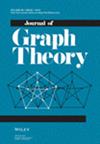求助PDF
{"title":"在线性时间内对具有树状骨干的小群进行λ $\\lambda $骨干着色","authors":"Krzysztof Michalik, Krzysztof Turowski","doi":"10.1002/jgt.23108","DOIUrl":null,"url":null,"abstract":"<p>A <span></span><math>\n <semantics>\n <mrow>\n <mi>λ</mi>\n </mrow>\n <annotation> $\\lambda $</annotation>\n </semantics></math>-backbone coloring of a graph <span></span><math>\n <semantics>\n <mrow>\n <mi>G</mi>\n </mrow>\n <annotation> $G$</annotation>\n </semantics></math> with its subgraph (also called a <i>backbone</i>) <span></span><math>\n <semantics>\n <mrow>\n <mi>H</mi>\n </mrow>\n <annotation> $H$</annotation>\n </semantics></math> is a function <span></span><math>\n <semantics>\n <mrow>\n <mi>c</mi>\n \n <mo>:</mo>\n \n <mi>V</mi>\n <mrow>\n <mo>(</mo>\n \n <mi>G</mi>\n \n <mo>)</mo>\n </mrow>\n \n <mo>→</mo>\n <mrow>\n <mo>{</mo>\n <mrow>\n <mn>1</mn>\n \n <mo>,</mo>\n \n <mi>…</mi>\n \n <mo>,</mo>\n \n <mi>k</mi>\n </mrow>\n \n <mo>}</mo>\n </mrow>\n </mrow>\n <annotation> $c:V(G)\\to \\{1,\\ldots ,k\\}$</annotation>\n </semantics></math> ensuring that <span></span><math>\n <semantics>\n <mrow>\n <mi>c</mi>\n </mrow>\n <annotation> $c$</annotation>\n </semantics></math> is a proper coloring of <span></span><math>\n <semantics>\n <mrow>\n <mi>G</mi>\n </mrow>\n <annotation> $G$</annotation>\n </semantics></math> and for each <span></span><math>\n <semantics>\n <mrow>\n <mrow>\n <mo>{</mo>\n <mrow>\n <mi>u</mi>\n \n <mo>,</mo>\n \n <mi>v</mi>\n </mrow>\n \n <mo>}</mo>\n </mrow>\n \n <mo>∈</mo>\n \n <mi>E</mi>\n <mrow>\n <mo>(</mo>\n \n <mi>H</mi>\n \n <mo>)</mo>\n </mrow>\n </mrow>\n <annotation> $\\{u,v\\}\\in E(H)$</annotation>\n </semantics></math> it holds that <span></span><math>\n <semantics>\n <mrow>\n <mo>|</mo>\n \n <mi>c</mi>\n <mrow>\n <mo>(</mo>\n \n <mi>u</mi>\n \n <mo>)</mo>\n </mrow>\n \n <mo>−</mo>\n \n <mi>c</mi>\n <mrow>\n <mo>(</mo>\n \n <mi>v</mi>\n \n <mo>)</mo>\n </mrow>\n \n <mo>|</mo>\n \n <mo>≥</mo>\n \n <mi>λ</mi>\n </mrow>\n <annotation> $|c(u)-c(v)|\\ge \\lambda $</annotation>\n </semantics></math>. In this paper we propose a way to color cliques with tree and forest backbones in linear time that the largest color does not exceed <span></span><math>\n <semantics>\n <mrow>\n <mi>max</mi>\n <mrow>\n <mo>{</mo>\n <mrow>\n <mi>n</mi>\n \n <mo>,</mo>\n \n <mn>2</mn>\n \n <mi>λ</mi>\n </mrow>\n \n <mo>}</mo>\n </mrow>\n \n <mo>+</mo>\n \n <mi>Δ</mi>\n \n <msup>\n <mrow>\n <mo>(</mo>\n \n <mi>H</mi>\n \n <mo>)</mo>\n </mrow>\n \n <mn>2</mn>\n </msup>\n <mrow>\n <mo>⌈</mo>\n <mrow>\n <mi>log</mi>\n \n <mi>n</mi>\n </mrow>\n \n <mo>⌉</mo>\n </mrow>\n </mrow>\n <annotation> $\\max \\{n,2\\lambda \\}+{\\rm{\\Delta }}{(H)}^{2}\\lceil \\mathrm{log}n\\rceil $</annotation>\n </semantics></math>. This result improves on the previously existing approximation algorithms as it is <span></span><math>\n <semantics>\n <mrow>\n <mo>(</mo>\n <mrow>\n <mi>Δ</mi>\n \n <msup>\n <mrow>\n <mo>(</mo>\n \n <mi>H</mi>\n \n <mo>)</mo>\n </mrow>\n \n <mn>2</mn>\n </msup>\n <mrow>\n <mo>⌈</mo>\n <mrow>\n <mi>log</mi>\n \n <mi>n</mi>\n </mrow>\n \n <mo>⌉</mo>\n </mrow>\n </mrow>\n \n <mo>)</mo>\n </mrow>\n <annotation> $({\\rm{\\Delta }}{(H)}^{2}\\lceil \\mathrm{log}n\\rceil )$</annotation>\n </semantics></math>-absolutely approximate, that is, with an additive error over the optimum. We also present an infinite family of trees <span></span><math>\n <semantics>\n <mrow>\n <mi>T</mi>\n </mrow>\n <annotation> $T$</annotation>\n </semantics></math> with <span></span><math>\n <semantics>\n <mrow>\n <mi>Δ</mi>\n <mrow>\n <mo>(</mo>\n \n <mi>T</mi>\n \n <mo>)</mo>\n </mrow>\n \n <mo>=</mo>\n \n <mn>3</mn>\n </mrow>\n <annotation> ${\\rm{\\Delta }}(T)=3$</annotation>\n </semantics></math> for which the coloring of cliques with backbones <span></span><math>\n <semantics>\n <mrow>\n <mi>T</mi>\n </mrow>\n <annotation> $T$</annotation>\n </semantics></math> requires at least <span></span><math>\n <semantics>\n <mrow>\n <mi>max</mi>\n <mrow>\n <mo>{</mo>\n <mrow>\n <mi>n</mi>\n \n <mo>,</mo>\n \n <mn>2</mn>\n \n <mi>λ</mi>\n </mrow>\n \n <mo>}</mo>\n </mrow>\n \n <mo>+</mo>\n \n <mi>Ω</mi>\n <mrow>\n <mo>(</mo>\n <mrow>\n <mi>log</mi>\n \n <mi>n</mi>\n </mrow>\n \n <mo>)</mo>\n </mrow>\n </mrow>\n <annotation> $\\max \\{n,2\\lambda \\}+{\\rm{\\Omega }}(\\mathrm{log}n)$</annotation>\n </semantics></math> colors for <span></span><math>\n <semantics>\n <mrow>\n <mi>λ</mi>\n </mrow>\n <annotation> $\\lambda $</annotation>\n </semantics></math> close to <span></span><math>\n <semantics>\n <mrow>\n <mfrac>\n <mi>n</mi>\n \n <mn>2</mn>\n </mfrac>\n </mrow>\n <annotation> $\\frac{n}{2}$</annotation>\n </semantics></math>. The construction draws on the theory of Fibonacci numbers, particularly on Zeckendorf representations.</p>","PeriodicalId":16014,"journal":{"name":"Journal of Graph Theory","volume":"107 1","pages":"5-28"},"PeriodicalIF":0.9000,"publicationDate":"2024-04-29","publicationTypes":"Journal Article","fieldsOfStudy":null,"isOpenAccess":false,"openAccessPdf":"","citationCount":"0","resultStr":"{\"title\":\"On \\n \\n \\n λ\\n \\n $\\\\lambda $\\n -backbone coloring of cliques with tree backbones in linear time\",\"authors\":\"Krzysztof Michalik, Krzysztof Turowski\",\"doi\":\"10.1002/jgt.23108\",\"DOIUrl\":null,\"url\":null,\"abstract\":\"<p>A <span></span><math>\\n <semantics>\\n <mrow>\\n <mi>λ</mi>\\n </mrow>\\n <annotation> $\\\\lambda $</annotation>\\n </semantics></math>-backbone coloring of a graph <span></span><math>\\n <semantics>\\n <mrow>\\n <mi>G</mi>\\n </mrow>\\n <annotation> $G$</annotation>\\n </semantics></math> with its subgraph (also called a <i>backbone</i>) <span></span><math>\\n <semantics>\\n <mrow>\\n <mi>H</mi>\\n </mrow>\\n <annotation> $H$</annotation>\\n </semantics></math> is a function <span></span><math>\\n <semantics>\\n <mrow>\\n <mi>c</mi>\\n \\n <mo>:</mo>\\n \\n <mi>V</mi>\\n <mrow>\\n <mo>(</mo>\\n \\n <mi>G</mi>\\n \\n <mo>)</mo>\\n </mrow>\\n \\n <mo>→</mo>\\n <mrow>\\n <mo>{</mo>\\n <mrow>\\n <mn>1</mn>\\n \\n <mo>,</mo>\\n \\n <mi>…</mi>\\n \\n <mo>,</mo>\\n \\n <mi>k</mi>\\n </mrow>\\n \\n <mo>}</mo>\\n </mrow>\\n </mrow>\\n <annotation> $c:V(G)\\\\to \\\\{1,\\\\ldots ,k\\\\}$</annotation>\\n </semantics></math> ensuring that <span></span><math>\\n <semantics>\\n <mrow>\\n <mi>c</mi>\\n </mrow>\\n <annotation> $c$</annotation>\\n </semantics></math> is a proper coloring of <span></span><math>\\n <semantics>\\n <mrow>\\n <mi>G</mi>\\n </mrow>\\n <annotation> $G$</annotation>\\n </semantics></math> and for each <span></span><math>\\n <semantics>\\n <mrow>\\n <mrow>\\n <mo>{</mo>\\n <mrow>\\n <mi>u</mi>\\n \\n <mo>,</mo>\\n \\n <mi>v</mi>\\n </mrow>\\n \\n <mo>}</mo>\\n </mrow>\\n \\n <mo>∈</mo>\\n \\n <mi>E</mi>\\n <mrow>\\n <mo>(</mo>\\n \\n <mi>H</mi>\\n \\n <mo>)</mo>\\n </mrow>\\n </mrow>\\n <annotation> $\\\\{u,v\\\\}\\\\in E(H)$</annotation>\\n </semantics></math> it holds that <span></span><math>\\n <semantics>\\n <mrow>\\n <mo>|</mo>\\n \\n <mi>c</mi>\\n <mrow>\\n <mo>(</mo>\\n \\n <mi>u</mi>\\n \\n <mo>)</mo>\\n </mrow>\\n \\n <mo>−</mo>\\n \\n <mi>c</mi>\\n <mrow>\\n <mo>(</mo>\\n \\n <mi>v</mi>\\n \\n <mo>)</mo>\\n </mrow>\\n \\n <mo>|</mo>\\n \\n <mo>≥</mo>\\n \\n <mi>λ</mi>\\n </mrow>\\n <annotation> $|c(u)-c(v)|\\\\ge \\\\lambda $</annotation>\\n </semantics></math>. In this paper we propose a way to color cliques with tree and forest backbones in linear time that the largest color does not exceed <span></span><math>\\n <semantics>\\n <mrow>\\n <mi>max</mi>\\n <mrow>\\n <mo>{</mo>\\n <mrow>\\n <mi>n</mi>\\n \\n <mo>,</mo>\\n \\n <mn>2</mn>\\n \\n <mi>λ</mi>\\n </mrow>\\n \\n <mo>}</mo>\\n </mrow>\\n \\n <mo>+</mo>\\n \\n <mi>Δ</mi>\\n \\n <msup>\\n <mrow>\\n <mo>(</mo>\\n \\n <mi>H</mi>\\n \\n <mo>)</mo>\\n </mrow>\\n \\n <mn>2</mn>\\n </msup>\\n <mrow>\\n <mo>⌈</mo>\\n <mrow>\\n <mi>log</mi>\\n \\n <mi>n</mi>\\n </mrow>\\n \\n <mo>⌉</mo>\\n </mrow>\\n </mrow>\\n <annotation> $\\\\max \\\\{n,2\\\\lambda \\\\}+{\\\\rm{\\\\Delta }}{(H)}^{2}\\\\lceil \\\\mathrm{log}n\\\\rceil $</annotation>\\n </semantics></math>. This result improves on the previously existing approximation algorithms as it is <span></span><math>\\n <semantics>\\n <mrow>\\n <mo>(</mo>\\n <mrow>\\n <mi>Δ</mi>\\n \\n <msup>\\n <mrow>\\n <mo>(</mo>\\n \\n <mi>H</mi>\\n \\n <mo>)</mo>\\n </mrow>\\n \\n <mn>2</mn>\\n </msup>\\n <mrow>\\n <mo>⌈</mo>\\n <mrow>\\n <mi>log</mi>\\n \\n <mi>n</mi>\\n </mrow>\\n \\n <mo>⌉</mo>\\n </mrow>\\n </mrow>\\n \\n <mo>)</mo>\\n </mrow>\\n <annotation> $({\\\\rm{\\\\Delta }}{(H)}^{2}\\\\lceil \\\\mathrm{log}n\\\\rceil )$</annotation>\\n </semantics></math>-absolutely approximate, that is, with an additive error over the optimum. We also present an infinite family of trees <span></span><math>\\n <semantics>\\n <mrow>\\n <mi>T</mi>\\n </mrow>\\n <annotation> $T$</annotation>\\n </semantics></math> with <span></span><math>\\n <semantics>\\n <mrow>\\n <mi>Δ</mi>\\n <mrow>\\n <mo>(</mo>\\n \\n <mi>T</mi>\\n \\n <mo>)</mo>\\n </mrow>\\n \\n <mo>=</mo>\\n \\n <mn>3</mn>\\n </mrow>\\n <annotation> ${\\\\rm{\\\\Delta }}(T)=3$</annotation>\\n </semantics></math> for which the coloring of cliques with backbones <span></span><math>\\n <semantics>\\n <mrow>\\n <mi>T</mi>\\n </mrow>\\n <annotation> $T$</annotation>\\n </semantics></math> requires at least <span></span><math>\\n <semantics>\\n <mrow>\\n <mi>max</mi>\\n <mrow>\\n <mo>{</mo>\\n <mrow>\\n <mi>n</mi>\\n \\n <mo>,</mo>\\n \\n <mn>2</mn>\\n \\n <mi>λ</mi>\\n </mrow>\\n \\n <mo>}</mo>\\n </mrow>\\n \\n <mo>+</mo>\\n \\n <mi>Ω</mi>\\n <mrow>\\n <mo>(</mo>\\n <mrow>\\n <mi>log</mi>\\n \\n <mi>n</mi>\\n </mrow>\\n \\n <mo>)</mo>\\n </mrow>\\n </mrow>\\n <annotation> $\\\\max \\\\{n,2\\\\lambda \\\\}+{\\\\rm{\\\\Omega }}(\\\\mathrm{log}n)$</annotation>\\n </semantics></math> colors for <span></span><math>\\n <semantics>\\n <mrow>\\n <mi>λ</mi>\\n </mrow>\\n <annotation> $\\\\lambda $</annotation>\\n </semantics></math> close to <span></span><math>\\n <semantics>\\n <mrow>\\n <mfrac>\\n <mi>n</mi>\\n \\n <mn>2</mn>\\n </mfrac>\\n </mrow>\\n <annotation> $\\\\frac{n}{2}$</annotation>\\n </semantics></math>. The construction draws on the theory of Fibonacci numbers, particularly on Zeckendorf representations.</p>\",\"PeriodicalId\":16014,\"journal\":{\"name\":\"Journal of Graph Theory\",\"volume\":\"107 1\",\"pages\":\"5-28\"},\"PeriodicalIF\":0.9000,\"publicationDate\":\"2024-04-29\",\"publicationTypes\":\"Journal Article\",\"fieldsOfStudy\":null,\"isOpenAccess\":false,\"openAccessPdf\":\"\",\"citationCount\":\"0\",\"resultStr\":null,\"platform\":\"Semanticscholar\",\"paperid\":null,\"PeriodicalName\":\"Journal of Graph Theory\",\"FirstCategoryId\":\"100\",\"ListUrlMain\":\"https://onlinelibrary.wiley.com/doi/10.1002/jgt.23108\",\"RegionNum\":3,\"RegionCategory\":\"数学\",\"ArticlePicture\":[],\"TitleCN\":null,\"AbstractTextCN\":null,\"PMCID\":null,\"EPubDate\":\"\",\"PubModel\":\"\",\"JCR\":\"Q2\",\"JCRName\":\"MATHEMATICS\",\"Score\":null,\"Total\":0}","platform":"Semanticscholar","paperid":null,"PeriodicalName":"Journal of Graph Theory","FirstCategoryId":"100","ListUrlMain":"https://onlinelibrary.wiley.com/doi/10.1002/jgt.23108","RegionNum":3,"RegionCategory":"数学","ArticlePicture":[],"TitleCN":null,"AbstractTextCN":null,"PMCID":null,"EPubDate":"","PubModel":"","JCR":"Q2","JCRName":"MATHEMATICS","Score":null,"Total":0}
引用次数: 0
引用
批量引用


